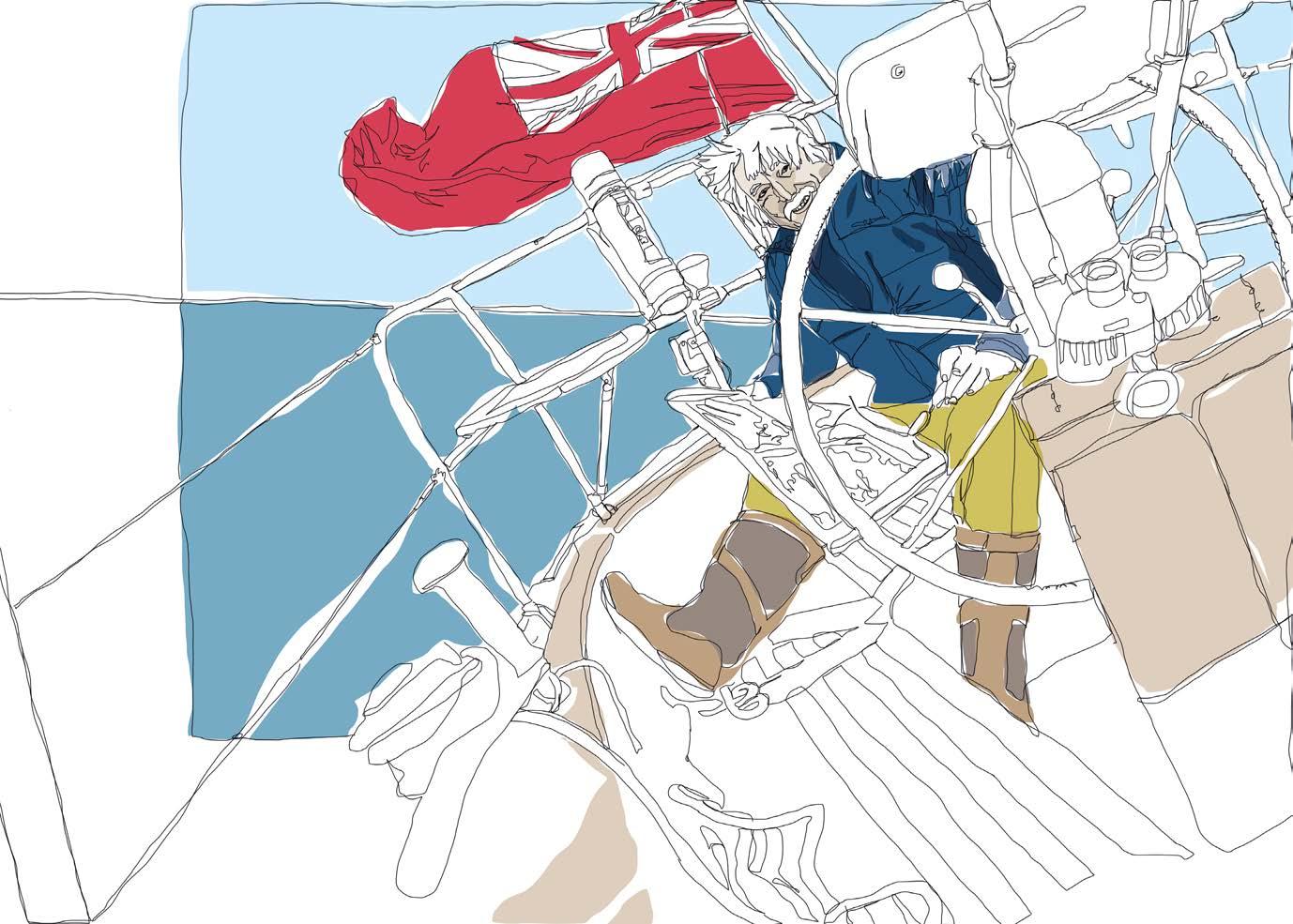
9 minute read
RORC Transatlantic
Ocean showdown
With a bumper entry and race records up for grabs, competition in the RORC Transatlantic Race is expected to be fierce. As preparations got underway Georgie Corlett-Pitt talked to the biggest and the smallest yachts in the fleet
Now in its eighth edition, the RORC Transatlantic Race has evolved from what was originally intended as a feeder race to the
Caribbean season (in particular for the RORC Caribbean 600) into a high calibre showdown between some of the world’s most notable race yachts. Competing alongside them will be a number of Corinthian teams keen to test their ocean racing skills. With a record entry for 2022's event, the fleet will set off from Puerto Calero, Lanzarote on 8 January. 3000nm of Atlantic Ocean lies ahead, with the finish line lying off Grenada where a warm welcome awaits at Camper & Nicholson’s Port Louis Marina.
Organised by the Royal Ocean Racing Club, in association with the International Maxi Association and, for the first time, the Yacht Club de France, the entry list includes high performance monohulls, giant multihulls, classic yachts, performance cruisers and double-handed teams.
ABOVE
The 100ft Maxi Comanche is the largest monohull and will be leading the charge for line honours
Record chasing giant
By far the largest monohull in the fleet is Comanche, the well-known 100ft canting keel Maxi currently skippered by Australian legend Mitch Booth. It’s no surprise that Comanche’s aim for the race is to break the record – set back in 2018 by Pier Luigi Loro Piana’s Supermaxi My Song – of 10 days 5 hours 47 minutes.
Launched in 2014, the VPLPVerdier designed Comanche was solely built to chase records; the boat is current holder of the Monohull
West-East Transatlantic sailing record, and with an impressive list of previous line honour wins to her name, including the Rolex Fastnet Race, the RORC Caribbean 600, the Rolex Sydney Hobart, the Transpac and the Rolex Middle Sea Race, there’s no doubting her pedigree.
Comanche’s super beamy transom – that led to the nickname ‘the aircraft carrier’ when first launched – lends itself perfectly to the largely offwind course of this race, and skipper Mitch Booth fully expects her to be in her element. “The RORC Transatlantic Race is one of the iconic offshore events and well suited for Comanche. The trade winds this time of year are the perfect recipe for some great sailing,” he says.
Asked what the boat is like to sail in these conditions, he describes: “Comanche is really just a big skiff and as soon we can crack sheets, she starts planing. The faster you go, the more sensitive the helm becomes.”
Having set a Transatlantic record once before (on the 110ft Maxicatamaran ClubMed) Mitch is relishing the prospect of entering this particular race. He acknowledges the challenge they’ve set themselves when he says: “Setting a race record doesn’t allow you to choose the right weather window and the current race record is fast – but it’s beatable. We have a couple of the My Song crew in our team and we are looking forward to having a crack at it.”
Comanche's crew will be handpicked from a tight knit bunch that has spent the 2021 season together - the likes of Justin Slattery, Shannon Falcone, Will Oxley and Pete Cumming. The all-star team are looking forward to arriving in Lanzarote and making their final preparations for this, the longest offshore in the RORC calendar.
“We have focused on reliability of the equipment and on the other hand reducing weight,” Mitch explains. “We will race with a few less crew than inshore events; we would normally race with between 22-27 inshore, and 19-22 offshore. People equate to weight, and for longer offshores it adds up, including food, clothing, etc. Equipment is also weight, but for sure it is well worth taking spares. Sails are another area of balancing weight and so we are giving careful considerations as to what sails to carry on board.”
With such a pinnacle race record up for grabs, it’s sure that Mitch and his crew will do everything it takes to push Comanche towards their goal, and it’s sure to be an intense ride for those making the cut.


ABOVE
Richard Palmer on Jangada, arriving at the end of the 2019 race as overall winner on corrected time
70FT MULTIS GO HEAD TO HEAD
For the giant multihulls, a transatlantic challenge such as this is hard to resist. Three MOD70 trimarans will set off from Lanzarote, hoping to beat the race record of 5 days 22 hours 46 minutes, set in 2015 by Lloyd Thornburg’s MOD70 Phaedo 3, then skippered by Britain’s Brian Thompson. Brian is once again racing, this time on board Jason Carroll’s MOD70 Argo (USA). He goes up against 2018 race winner Giovanni Soldini’s Maserati Multi70 (ITA) and the boat that tailed her second over the line after a gripping trans-ocean match race, Peter Cunningham’s PowerPlay (ex Concise-10). With three boats, all capable of foiling about 40 knots, Brian predicts an enthralling race. “The boat that is behind will always be trying to break away from the leaders and the front boat will have to decide who to cover. The race tracker will also come into play, ABOVE LEFT with teams choosing to make a move just after an xxx update. If the data is only updated every four hours, ABOVE RIGHT there could be 240 miles of separation between the xxxx boats, and that move would be very hard to cover.” Also in action and gunning for line honours will be Antoine Rabaste’s 80ft Ultim’Emotion 2 (FRA).

Smallest for the win?
Also arriving early in Lanzarote will be Richard Palmer’s JPK 1010 Jangada, overall winner under IRC of the 2019 RORC Transatlantic Race. Jangada is once again the smallest yacht entered, both in terms of size and crew – with co-skipper Jeremy Waitt bringing the team to a grand total of two. Fresh from a win in the IRC Two-Handed class at the recent Rolex Middle Sea Race, Jangada is aiming to be the first double-handed boat to win the 2022 RORC Season’s Points Championship overall - of which this race is the second of 16 events. Having come close to doing so in 2019-20 only to have his efforts thwarted by the pandemic, Richard believes that consistency throughout the coming season will be key to achieving his goal.
As for this particular race, it’s the third time Jangada has entered. Used to being at the smallest end of the scale, Richard says this doesn’t necessarily entail a disadvantage, providing you are prepared to manage risk carefully. This typically means adopting a conservative strategy. “We will be ensuring we do not go out on a limb and risk a very poor result. As the lowest rated boat we have the benefit of tracking the fleet ahead of us,” he explains.
With Jangada favouring 15-20kts, the prospect of some solid surf conditions is an appealing one, but with a hull length less than one-third of Comanche’s Richard naturally has to adopt a different set of priorities; in particular sea state is a far bigger determining factor and so as waves build, Richard and Jeremy will need to be ready to respond much earlier than their larger rivals. Richard cites
their fractional A5 spinnaker as a go-to in these circumstances, which he describes as “very forgiving, even in a broach”.
As with Comanche, Jangada’s sails and equipment have been carefully selected, and importantly, already tried and tested on the race-track. Richard says: “We double up on many systems, such as autopilot and charging batteries. All of that starts before we even leave the dock in Cowes. We also try to avoid last minute changes.”
Overall says Richard, “The biggest challenge will be managing the balance between pushing hard for that extra fraction of a knot versus conserving both the boat and our ourselves. Particularly sailing short-handed, it’s essential that we both stay alert and able to perform to our best ability. So that means as much sleep as possible, and staying hydrated especially in the fierce heat of the tropical sun.
“We will also be on the look out for Sargasso seaweed, which with twin rudders can be a problem!”
Could history repeat and we see the overall win go to the smallest boat in the fleet for a second time? Richard is certainly keen to beat his previous race time of 17 days 10 hours 11 minutes and modestly admits he hopes for another chance of lifting the trophy. But he says, “Not only do we have a larger fleet this time but the level of competition is very high, so a win will be tough. We will be dependant upon the weather systems and the extent to which they may favour the smaller boats. For sure we will race to win, so anything is possible!”


Stiff competition
Topped by a powerful 100ft record chaser and tailed by a small but mighty and well-proven offshore duo, what can we expect from the other monohulls making up the rest of the fleet? Looking to lead will be two highly competitive Volvo 70s; Lance Shepherd’s Telefonica Black and HYPR, skippered by Jens Lindner, as well as Richard Tolkien’s Open 60 Rosalba (GBR). Competition is expected to be just as hot among those under 60ft, and includes David Collins’ Botin IRC 52 Tala (GBR), winner of IRC Zero in the Rolex Fastnet Race, plus several newbies: Maximilian Klink’s new Botin 52 Caro (GER) and Arto Linnervuo’s new Infiniti 52 Tulikettu (FIN).
At sub 50ft the action is no less intense, with entries including second overall in the 2019 race, Lombard 46 Pata Negra (GBR) under new ownership of Andrew Hall, and ARC winner (see page 84) Ross Appleby’s Oyster 48 Scarlet Oyster (GBR) making a RORC Transatlantic debut.
Another first timer is Christopher Daniel’s J/122E Juno, sailing with a fully Corinthian crew of friends and family, including children, Jack and Poppy. A regular inshore winner on the Solent, this is a pinnacle event for Juno in 2021-22 having already ticked off the Fastnet and Middle Sea Races, and - still to come - the Caribbean 600.
Christopher speaks highly of his crew when he says: “They all have been totally committed to the programme and taking responsibility for their respective areas and roles in the preparation for each race.”
And of the race ahead he says: “The key challenge for us will be analysing the trade-off between sailing the rumbline and heating up and reaching, but sailing longer distances. A J/122 isn’t a planing boat so the solution to max VMG is always much more nuanced, despite the temptation to always sail higher and faster!” Follow the race via the online tracker and enter the virtual edition at: rorctransatlantic.rorc.org
ABOVE
Five-times ARC winner Ross Appleby's Scarlet Oyster enters this race for the first time
BELOW
Christopher Daniel's J/122E also debuts, with a Corinthian crew of family and friends










